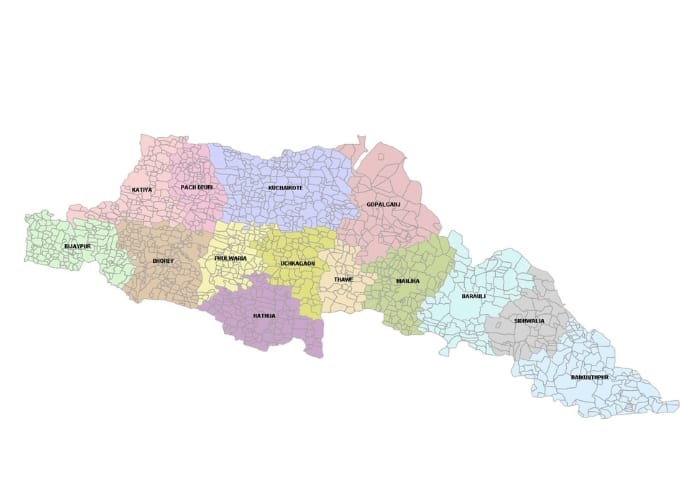Population Gopalganj, Bihar
According to the 2011 Census of India, the total population of Gopalganj district was approximately 2.56 million (25.6 lakhs). The district has witnessed a steady increase in population over the past few decades. From a population of around 1.5 million in the 1981 Census to over 2.5 million in 2011, Gopalganj has experienced consistent demographic expansion, reflective of both natural growth and limited migration patterns.
The population density in Gopalganj was 1,278 persons per square kilometer as per the 2011 census, which is considerably higher than the national average and indicates the pressure on land and resources in the region. With increasing urbanization and better access to amenities, the trend of population growth is likely to continue, albeit at a possibly slower rate due to evolving migration trends and family planning awareness.


Urban and Rural Distribution
Gopalganj is primarily a rural district. Around 93% of the population lives in rural areas, while only about 7% resides in urban centers. The urban population is concentrated in towns like Gopalganj (the district headquarters), Mirganj, and Barauli. Despite urban areas accounting for a small fraction of the population, they are growing rapidly due to better employment opportunities, educational institutions, and infrastructure.
The rural character of the district is deeply rooted in its agrarian economy and cultural traditions. Villages in Gopalganj are typically densely populated, with joint family systems still prevalent in many parts.
Sex Ratio and Gender Distribution
The sex ratio in Gopalganj stands at 1,016 females per 1,000 males, which is higher than both the state average of Bihar (918) and the national average (943). This relatively balanced gender ratio is a positive indicator and suggests progress in gender equity compared to other regions in Bihar.
However, the child sex ratio (0-6 years) is lower than the overall ratio, at around 941, indicating a need for continued efforts to combat gender bias and promote female child welfare. Government schemes promoting girl child education and healthcare have seen some success, but persistent cultural preferences still influence these numbers.
Literacy Rate
As of 2011, the literacy rate in Gopalganj was approximately 65.5%, which, while lower than the national average (74.04%), is higher than Bihar’s overall literacy rate of around 61.8%. Male literacy in Gopalganj stands at around 75.5%, while female literacy is approximately 55.7%.
The literacy gap between males and females reflects the educational disparity and societal challenges women face in accessing education. However, with the establishment of more schools, mid-day meal schemes, and awareness campaigns, educational access is gradually improving in both urban and rural areas.
Occupational and Economic Demographics
Agriculture remains the backbone of the economy in Gopalganj, with a large proportion of the population engaged in farming and allied activities. Paddy, wheat, maize, and sugarcane are the primary crops grown in the district. Small-scale industries, such as food processing and handloom weaving, also provide employment to locals.
Out-migration for employment is a notable feature of Gopalganj’s population. A significant number of people, especially the youth, migrate to metropolitan cities like Delhi, Mumbai, and Kolkata in search of better job opportunities. Remittances from these migrants play a crucial role in the local economy.
Religion and Cultural Composition
The majority of Gopalganj’s population is Hindu, with a substantial Muslim minority. Religious harmony and cultural festivals are a vibrant part of the district’s social life. Chhath Puja, Holi, Diwali, Eid, and Muharram are celebrated with equal enthusiasm, reflecting the district’s inclusive cultural ethos.
The linguistic landscape is dominated by Bhojpuri, the most commonly spoken language, though Hindi is used for official communication and education. Urdu is also prevalent among the Muslim population.
Youth Population and Demographic Dividend
A significant proportion of Gopalganj’s population is under the age of 30, giving it a demographic advantage. This young population presents both an opportunity and a challenge. If provided with the right skills, education, and employment opportunities, they can drive economic growth. However, if left unaddressed, this could lead to increased unemployment and social unrest.
Vocational training programs and government initiatives aimed at youth skill development are being introduced in the district, but their reach and effectiveness need to be expanded to cover more young individuals, especially from marginalized communities.
Conclusion
The population of Gopalganj, Bihar, offers a microcosmic view of the larger demographic trends of northern India. While challenges remain, the district also holds immense potential due to its youthful population, agricultural base, and evolving infrastructure. Understanding and planning for the needs of this population is crucial for sustainable development and improved living standards in the region.

